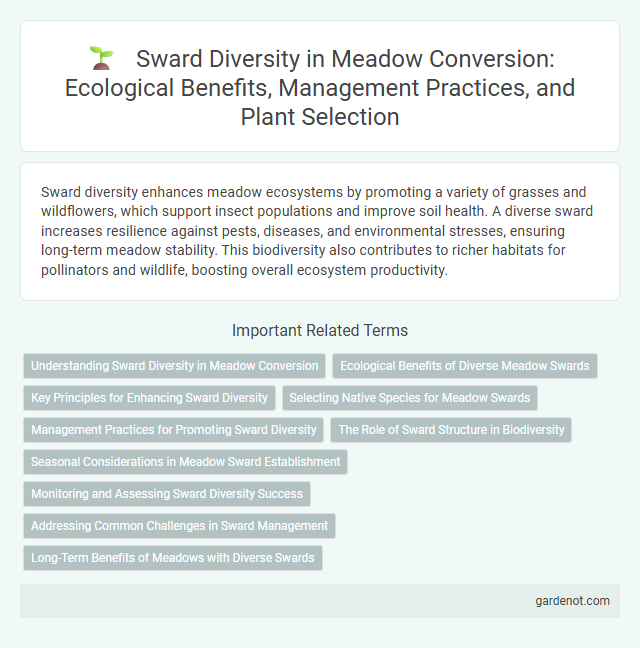Sward diversity enhances meadow ecosystems by promoting a variety of grasses and wildflowers, which support insect populations and improve soil health. A diverse sward increases resilience against pests, diseases, and environmental stresses, ensuring long-term meadow stability. This biodiversity also contributes to richer habitats for pollinators and wildlife, boosting overall ecosystem productivity.
Understanding Sward Diversity in Meadow Conversion
Sward diversity plays a critical role in successful meadow conversion, influencing ecosystem health and resilience. High diversity in grass and forb species enhances soil structure, nutrient cycling, and habitat complexity, supporting pollinators and wildlife. Understanding sward composition and managing for heterogeneous species mixtures can maximize ecological benefits and long-term sustainability in converted meadows.
Ecological Benefits of Diverse Meadow Swards
Diverse meadow swards enhance soil structure and increase nutrient cycling by supporting a wide range of root depths and microbial communities. These swards promote pollinator abundance and diversity, vital for ecosystem resilience and plant reproduction. Varied plant species in swards also improve habitat quality, supporting insects, birds, and small mammals essential for balanced ecosystems.
Key Principles for Enhancing Sward Diversity
Enhancing sward diversity hinges on incorporating a mix of native grasses, legumes, and wildflowers to promote ecological balance and resilience. Employing rotational grazing and varied mowing regimes supports different species' growth cycles, fostering a heterogeneous plant community. Maintaining soil health through minimal disturbance and organic amendments further encourages a rich and diverse sward composition.
Selecting Native Species for Meadow Swards
Selecting native species for meadow swards enhances biodiversity by supporting local ecosystems and wildlife habitats. Native plants are well-adapted to regional soil and climate conditions, ensuring sustainable growth and resilience. Incorporating a diverse range of native grasses and wildflowers creates structurally complex swards that improve soil health and promote pollinator activity.
Management Practices for Promoting Sward Diversity
Effective meadow conversion requires targeted management practices to promote sward diversity by integrating rotational grazing and periodic mowing, which prevent dominance of aggressive species and encourage a variety of grasses and wildflowers. Soil fertility management through reduced fertilizer application supports the establishment of native species, enhancing ecological balance and biodiversity within the sward. Incorporating seasonal disturbance regimes and avoiding overgrazing ensures maintenance of structural complexity, critical for sustaining diverse plant communities and associated fauna.
The Role of Sward Structure in Biodiversity
Sward structure plays a critical role in promoting biodiversity by creating diverse microhabitats that support a wide range of flora and fauna. Variations in sward height, density, and species composition enhance ecological niches, encouraging pollinators, insects, and ground-nesting birds to thrive. Optimizing sward heterogeneity in meadow conversion projects significantly improves ecosystem resilience and overall biodiversity.
Seasonal Considerations in Meadow Sward Establishment
Seasonal considerations play a crucial role in meadow sward establishment, influencing species composition and growth dynamics throughout the year. Early spring sowing promotes rapid germination of cool-season grasses and wildflowers, while late summer planting benefits from residual soil moisture supporting warm-season species. Understanding these seasonal windows ensures optimal sward diversity, enhancing habitat quality and ecosystem resilience in meadow conversion projects.
Monitoring and Assessing Sward Diversity Success
Monitoring and assessing sward diversity success involves regular botanical surveys to quantify species richness and cover, using metrics such as the Shannon Index and Simpson's Diversity Index to evaluate ecosystem health. Remote sensing technologies and drone imagery provide detailed data on spatial heterogeneity and temporal changes, enabling precise tracking of species composition shifts. Integrating soil quality analysis with vegetation monitoring enhances understanding of environmental factors affecting sward diversity and informs adaptive meadow conversion management strategies.
Addressing Common Challenges in Sward Management
Maintaining high sward diversity in meadow conversion requires tackling issues such as soil nutrient imbalance, invasive species encroachment, and uneven grazing pressure. Implementing rotational grazing and selective mowing supports species richness by preventing dominance of aggressive grasses. Soil testing and tailored fertilization improve conditions for diverse plant establishment, addressing common challenges in sward management.
Long-Term Benefits of Meadows with Diverse Swards
Meadows with diverse swards enhance ecosystem resilience by supporting a wide range of pollinators and wildlife, promoting soil health through varied root structures and nutrient cycling. This biodiversity fosters long-term sustainability, reducing the need for chemical inputs and mitigating the impacts of climate change. Over time, diverse sward meadows improve productivity and ecosystem services, contributing to agricultural success and environmental conservation.
Sward diversity Infographic

 gardenot.com
gardenot.com